Enjoying the Winter Landscape
Posted on Friday, December 16, 2022 · Leave a Comment
Normally at this time of year I can go out to the stream behind my house and pick stems of a shrub called winterberry (Ilex verticillata) to use in vases and on my wreath. It is generally loaded with small red berries that persist until mid-winter when hungry birds eat them, or they just plain fall off.

Winterberry grows best in wet places
Winterberry is a great decorative shrub in winter that prefers wet feet, but will grow in ordinary garden soil, too. It is dioecious, meaning that it requires male and female plants – usually one male will take care of all the females. This year I didn’t get many of those bright red berries I like so much for decoration, and I have heard from other gardeners that they had few, too.
This prompted me to walk around my property looking at my woody shrubs to see what might substitute for winterberries. I didn’t find any berries at all. But I did cut some red-twigged dogwood (Cornus sericea) to use in a vase, and some budded branches of a Merrill magnolia (Magnolia x loebneri).
The magnolia buds are a bit like pussywillows on steroids: an inch long and very fuzzy. I have some in a vase on the table, and they look very good, and will for many weeks ahead. I’ve done this before, and will occasionally get a few buds to open into white flowers. I cut some greenery to go with them, a few stems of white pine. Hemlock would look good instead, but doesn’t hold needles well indoors.

It struck me that winter can be pretty bleak for people who don’t have nice looking winter shrubs and trees. Judicious pruning can turn transform a messy tree full of small branches going every which way into sculpture. I recently helped a client prune a 50-year old Japanese maple into sculpture that will keep it looking great for several years – with only a few minor pruning cuts each year.
When pruning, I ask myself, what will this little branch, currently the thickness of a finger, look like when it is the thickness of an arm – or a leg. If it is growing sideways toward a walkway, it must come off. Going through the middle of the tree? Remove it! The maple I pruned had many small dead branches that had been choked out because bigger branches had blocked off the sun, effectively starving them.
Bark is important. I like plants that have exfoliating bark, which means bark that is shaggy and peeling off – thus showing more than one color. My Seven Sons Flower Tree (Heptacodium miconioides) is one of those. In addition to the nice bark it offers me a display of small white flowers each fall. White birch (Betula papyrifera) and river birch (Betula nigra) are others with interesting bark. In fact all the birches have handsome bark.
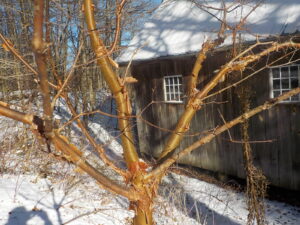
Paperbark maple has interesting bark for winter appreciation
I’ve been growing a paperbark maple (Acer griseum) for about 20 years. It has lovely shaggy reddish-brown bark that is very handsome. It is a very slow-growing tree, at least in this climate. It is listed as a Zone 5 plant (good to minus 20 F) but mine has survived colder temperatures. It looks great in winter
One of my favorites – but one I do not grow – is sycamore (Platanus occidentalis), which I knew growing up in Connecticut but is rare in New Hampshire where I live. It reminds me of the English plane tree, so common in Europe. The bark peels off in big swaths, showing light gray-green in some areas, dark brown in others. It is just barely hardy to Zone 4, and prefers to grow in river bottoms, but will grow in drier soils, too.
Of the bigger trees, I like American beech (Fagus sylvatica) for its smooth gray bark. Unfortunately, beeches are prone to a fungal disease that mars the bark and eventually kills the tree.
That same smooth bark is a prominent feature of a shrub known variously as shad bush, serviceberry and Saskatoon bush. All belong to the genus Amelanchier but bear different species names. Most are multi-stemmed bushes that get no more than 10 feet tall, though I have a wild one more than twice that height. Their blossoms are similar to apple blossoms. They do well in partial sun, often growing and blooming on roadsides.
Apple trees, particularly crabapples, can look great in winter. Some crabs hold onto their fruit throughout much of the winter, some drop their fruit in fall and many provide fruit for the birds to eat (that disappears before winter is done). Ask at the nursery when you buy a crabapple if the birds like the fruit. The form and bark of a well-pruned apple or crabapple is gorgeous to my eye.
So if your landscape has little to offer you in winter, plan on adding some winter interest come planting time. And if your trees and shrubs are drab, think about adding some strings of little winter lights to brighten them up, at least at night.
Henry is lifelong organic gardener, a UNH master Gardener, and the author of 4 gardening books. Reach him at PO Box 364, Cornish Flat, NH 03746 or by e-mail at
henry.homeyer@comcast.net.
Magnolias for New England
Posted on Tuesday, May 7, 2019 · Leave a Comment
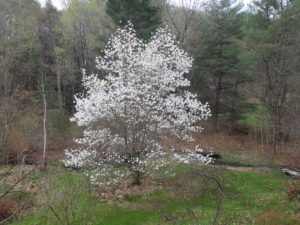
My Merrill Magnolia
One of my yearly high points occurs when my Merrill magnolia blooms. This year, and most years, mine blooms on my birthday, April 23. This year it opened that afternoon; some years it starts a week earlier and is fully in blossom; once or twice it has held off until May. Only once in 25 years has it failed to put on a great show, when there was a hard frost just before the buds were to open.
The Merrill magnolia is a “Loebner” hybrid, created by crossing the star magnolia (Magnolia stellata) with a Kobus magnolia. There are many Loebner varieties, and most are hardy from Zone 4 or 5 to 7 – fine for all of New England. Mine is white, with a soft light pink stripe on the outside of the petals (though technically they are tepals, not petals). And the blossoms are large – 4 inches or so – and fragrant. What more could you want? Other Loebner hybrids are pink or dark pink.
The Merrill magnolia does best in full sun and rich, moist soil. The literature says it needs well drained soil, but mine has thrived near my brook. The water table is near the soil surface all winter and spring, and only a couple of feet down in a dry summer. So I was not at all sure that mine would succeed. In the twenty years or so since I planted a 4-foot tall specimen, it has grown to an estimated 40 feet tall and 30 feet wide.
It really is a 4-season tree. The leaves are handsome all summer, turning a nice yellow in fall, and the flower buds are large and furry all winter, like pussy willows on steroids.

Jane Magnolia bud on September 28
I also have a smaller magnolia, a cultivar named ‘Jane’, that blooms later and stays smaller than my Merrill. It is one of the “Little Girl Hybrids”, a cross between a Magnolia liliiflora and M. stellata. Jane only gets to be 12 feet or so tall, and perhaps as wide. Her blossoms are deep pink in bud, and whitish inside when open. Like the Merrill, the leaves are shiny, glossy and beautiful.
One of Jane’s best characteristics is that she re-blooms throughout the summer and into the fall. Not a lot of blossoms, but a few. Just enough to make me stop in my tracks and exclaim every time I see a blossom. But frankly, the buds are better than the blossoms – perfect, each one. But the blossoms often develop a brown color once they open.
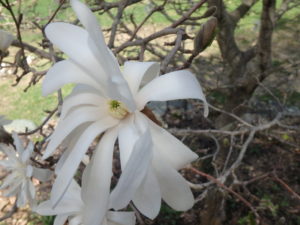
Star Magnolia
The star magnolia is a species magnolia, not a hybrid. It stays smaller than my big Merrill – perhaps to 15 or 20 feet tall and nearly as wide. So for smaller landscapes, it is a good choice. It is rated at hardy to Zone 4, but some grow in Zone 3. The blossoms are white, and come earlier than the Merrill – so they can be damaged by late frosts. There are single blossoms and double blossoms with extra petals.
Then there is the saucer magnolia (Magnolia x soulangiana). These are rated as Zone 4, but are most successful in Zone 5 or warmer. They are small trees, to a height of about 25 feet. The blossoms are amazing: up to 10 inches across in white, pink or purplish. Unfortunately, they bloom early and are often devastated by frost. These are commonly planted in Boston, probably because the heat of the buildings protects them against frost damage.
A neighbor of mine has a cucumber tree magnolia (Magnolia acuminata). This can get to be a huge tree – 50 to 80 feet tall. It is fast growing, perhaps 10 to 15 feet in six years. Its distinguishing characteristic, aside from size, is that is has yellow blossoms. Unfortunately, the blossoms are generally near the top of the tree, and can be masked by foliage. It does not do well in very dry or very wet soils, but will grow in full or partial sun.
When I interviewed the White House gardener many years ago I asked about the two huge southern magnolias (Magnolia grandiflora) that frame the back of the White House. They are magnificent. Dale Haney, the head gardener, told me that President Andrew Jackson brought them up from Tennessee as tiny saplings, on horseback. He planted them in 1830 in memory of his late wife and they have survived and thrived for nearly 200 years.
The southern magnolia is only hardy to Zone 6 or 7, so I can’t grow one here. Too bad. The flowers are 8 to 12 inches across, creamy white and superbly fragrant. But the trees grow to be 50 to 80 feet tall – and live forever, it would seem. They bloom in May or June.
Magnolias, in general, have fleshy roots and few root hairs. They do not transplant well, once established. So find the proper place before digging the hole. As with any tree, do not plant them too deep.
In nature, tree trunks flare out at the soil line. This trunk flare should never be buried at planting time or the bark, if covered with soil, will rot and destroy the cambium layer and eventually kill the tree. Many trees come from the nursery with the trunk flare buried, and it is important to remove the soil from the trunk flare before planting.
If could only bring one tree with me to a remote island, I suppose I’d have to take an apple tree for the food. But for beauty? I’d take a magnolia.
Henry Homeyer is the author of 4 gardening books.
Magnificent Trees for the Winter Landscape
Posted on Thursday, December 13, 2018 · Leave a Comment
This is not the time for planting trees in New England. But it is a good time for looking at them and deciding what to plant, come spring and summer. Since we have 5 months or so without flowers growing in our gardens, look at the silhouettes of trees, decide what pleases you, and read up on them.
Most gardeners plant some flowers, a few veggies and perhaps some nice decorative shrubs. Fine. But what about maples, oaks and beeches? Should we allow the squirrels to decide where these majestic trees grow on our property? No, we should plant them if we like them – and have space for them.
My property is relatively small, just a couple of acres, so I have been judicious in selecting trees to add to the landscape. My property came with a few big sugar maples and oaks, two American elms, one huge wild cherry and too many poplars for my liking. The elms died and had to be cut down, but the rest of the big trees continue to get even bigger, cooling the house in summer and providing food and homes for birds and small mammals.

My Merrill magnolia is gorgeous with a light coat of snow
One of my favorite big trees is a hybrid magnolia, the “Merrill”. I planted it about 20 years ago, and is near mature size now – at least 30 feet tall and wide. It blooms with big white fragrant blossoms every year in late April. It has glossy green leaves all summer, and fabulous fuzzy buds similar to pussy willows all winter. It was just 4 feet tall when I planted it.
I planted it in the middle of a lawn where it would get full sun. It is near my little stream and I worried that the high water table would lead to root rot, but it has thrived with plenty of water. Unfortunately it does spill some shade onto a vegetable plot in late afternoon. But I love it, and am glad I can see it from my windows.
I have planted several fruit trees, both apples and pears, and have several wild apples that blossom nicely but do not produce edible fruit. I think every gardener should have at least one apple tree. Books will tell you that you need 2 or more apples to get good pollination, but there are always wild apples, or apples at your neighbor’s house to provide good pollination if you have room for only one.
There are many disease-resistant apple varieties to choose from if you don’t want to spray chemicals. ‘Liberty’, ‘Freedom’, ‘MacFree’ and others are less likely to get apple scab, powdery mildew, cedar apple rust and fire blight. That said, be sure to pick an apple you have tasted and like. You can prune any apple tree to look good.
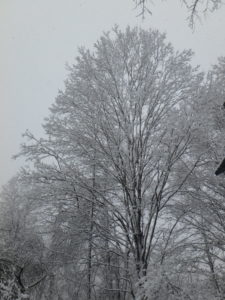
Snow covered sugar maple
Sugar maples mature more quickly than you might think. A tree with a 2-inch diameter stem can become a handsome shade tree in 20 years – they can average a foot a year or so. They don’t tolerate road salt or compacted soils, but otherwise are easy to grow. They can benefit from occasional doses of limestone for their roots, as acid rain washes calcium out of the soil, and they need it to stay healthy. Maples are, to me, the quintessential New England tree with the classic red, orange and yellows of our fall.
If you want a big oak in your yard, consider playing squirrel. A friend of mine did this, gathering acorns locally and planting a dozen or more. Some germinated, others did not, and some he had to thin out. Remember that a mature oak can reach 60 feet tall or more. Width can vary from 25 to 60 feet wide, depending on the species. One of the fastest growing oaks in the pin oak, which can reach 12 to 15 feet in 5 to 7 years.
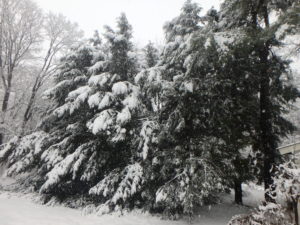
Hemlock hedge in winter
In 1972 I planted a row of hemlocks to create a privacy screen for the back yard. I dug them up from a field when they were 3 to 6 feet tall and planted them 10 to 20 feet apart. Now, nearly 50 years later, those hemlocks are feet 50 tall and do, indeed, create a nice living hedge.
I have to admit I did no research before planting the hemlocks. I didn’t know how tall they would get, nor how far apart I should plant them. But hemlocks are very adaptable and will grow in sun or shade, and in almost any kind of soil. They have done just fine.
Today I might not choose hemlocks for a screen because the wooly adelgid, a pest that thrives in southern New England, is moving north and may eventually decimate the hemlocks. White pine might be suitable for a hedge, but it, too, is facing diseases and is intolerant of air pollution and road salt. It is not a good tree near the road.
White birch (Betula papyrifera) is also a nice, easy tree to grow, and very handsome. The young stems are reddish brown when young, but turning chalky white after age 7 or so. I think the nicest way to plant them is in groups of 3, planted a couple of feet apart, or even in one big planting hole.
White birches will grow anywhere, but do especially well in sandy or rocky soils. I planted two near my stream in moist soil, and one died, the other thrived. Go figure.
Winter is the time to dream. Ask Santa for a good book on trees with lots of pictures. Anything by Michael Dirr would be good. Dream, read and plan!
Henry is away this week, and not answering e-mail. He is the author of 4 gardening books. His web site is www.Gardening-Guy.com.
Forcing Flowers of Shrubs and Trees
Posted on Monday, February 27, 2017 · Leave a Comment
When I was in first grade we learned a song about pussy willows that still rings in my head when I walk past the fire pond in Cornish Flat. Or it did recently when I saw pussy willows starting to pop open in a marshy area. Spring is here.
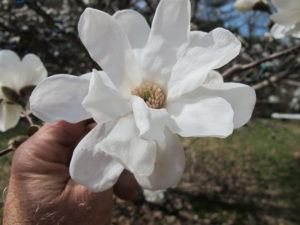
Merril magnolia
Pussy willows are actually the flowers of a wild shrub or small tree, the goat or pussy willow, also known by its scientific name, Salix caprea. This willow is a native to the United States and grows best in moist or soggy soils, or even in standing water. Full sun is best, but it can grow in part sun. It will grow up to 25 feet tall, but 15 feet is more common. The flowers grow on the top of the plant, so I use a pole pruner to get the branches I want.
Another willow, Salix discolor, is also a pussy willows but is “susceptible to a canker and is considered inferior for landscape use, though neither species is a plant of the first order.” That according to Michael Dirr in his book Manual of Woody Landscape Plants which I consider my bible of trees and shrubs.
He is right about pussy willows not being plants of the first order. Their time of glory is the spring, when the catkins or blossoms appear. The rest of the year it is a relatively unkempt, messy plant that spreads and is often too large to be considered a shrub, but not big enough to be considered a tree. The stems are weak, sometimes flopping over and easily breaking in ice storms. Still, if you have a wet area on your property, and like fat, fuzzy pussy willows in the spring, you should have some.
When I picked some pussy willow stems recently, I put them in a vase with water. This will encourage un-opened buds to open. Later, when all the blossoms are fully open, I will pour out the water and allow the stems to remain in a dry vase. This will prevent them from producing yellow pollen (which will fall on the table top) and allow me to have the fuzzies forever, or at as long as I want. One year, inadvertently, I kept a vase of pussy willows for a full year, and they still looked good!
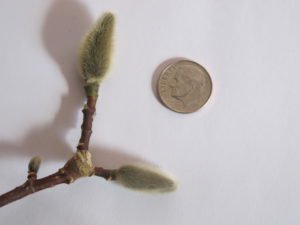
Magnolia bud (with dime for size comparison)
Another plant that can be forced to flower now looks similar to pussy willows at a quick look. I have a tree covered with fuzzy buds that are actually unopened flower buds that look like the pussy willow flowers. The hybrid magnolia ‘Merrill’ has these buds all winter, but when put in water now the buds will produce large white blossoms. Other magnolias have similar buds – like pussy willows on steroids.
The Merrill magnolia will generally bloom for me in late April. The closer to the date of outdoor blooming, the quicker buds will open in a vase indoors. I once did some pruning in December and forced magnolia buds indoors, but it took over a month for that to happen. Now it should happen in half that time (though pussy willow buds will open in just a few days).
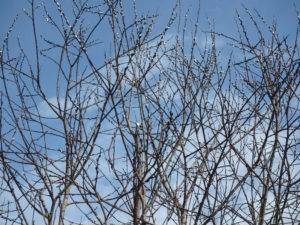
Merril Magnolia
My Merrill magnolia is one of my favorite trees. Mine is about 20 or 25 years old, and is roughly 30 feet tall with a 20 foot spread. When it blooms the flowers are bountiful – a thousand, perhaps – and magnificent. Each blossom is about 3 inches across and lightly fragrant. I recommend them as specimen trees in the middle of a lawn or field in full sun.
Another classic early spring shrub is forsythia. Like the daffodil, this early bloomer is bright yellow, a color I have come to associate with spring. It can be used as a hedge, or pruned into a vase-shaped shrub that stays relatively small, say 8 feet tall and 6 feet wide.
To get forsythia to bloom, pick stems that are more than one year old. New stems are generally straight, with few side branches and even fewer buds. The buds on new branches tend to be leaf buds. Older branches will be branched, and loaded with flower buds. And for best results, don’t forget to change the water in the vase every 2 or 3 days.
Forsythia is a nice enough plant, but like pussy willows, it is not my favorite. It is rambunctious, for starters. It wants to take over the world, sending out roots that then send up new plants. My neighbor planted a forsythia hedge, and now I have forsythia that has encroached onto my land. Fortunately, it is easy enough to control if you pull out new shoots early on. Or failing that, cut them back every year.
As a child, however, I loved forsythia. My gardening grandfather planted a double row of them between the house and the vegetable garden. As the plants grew and spread they became a dense thicket perhaps 40 feet long, 10 feet wide and 10 feet tall. My sister Ruth Anne and I discovered that if we crawled into this thicket there was a hidden ”room” in the middle where we could hide from adults on hot summer days.
Apple blossoms are great for forcing, too. When I prune in March I take branches with short fruit spurs, put them in a vase, and get flowers. At this time of year, one can’t have too many blossoms!
Read Henry’s twice-weekly blog at https://dailyuv.com/gardeningguy . You may e-mail him at henry.homeyer@comcast.net.
Enjoying the Winter Landscape
Posted on Wednesday, February 19, 2014 · Leave a Comment
I like winter. I like the special quality of winter light in the late afternoon, those purples and blues that were perfectly captured by artist Maxfield Parish. But most of all, I like passing through the woods on skis when the sun is bright. The snow sparkles the way diamonds might, if scattered on a Mediterranean beach.
I visit the woods in winter for the same reason that I go to museums: for the sheer beauty on display. There is something uplifting about great works of art – or great works of nature. I don’t need to go to the Grand Canyon to feel awe; I can enjoy the woods near home just as much. Part of the joy for me is going slowly enough to see what’s there, and taking time to appreciate the details.
As I approach my favorite woods, stolid maples wait patiently along the lane, old and venerable. They will share their sweet nectar in another month or two but for now they stand silently, motionless, waiting.
In the forest, young hemlocks bend under the weight of snow, their long arms reaching to the ground for stability, green fingers disappearing into the snow. Going through glades of mature hemlocks or pines, their branches reaching out high above me, is almost like visiting a great cathedral. I like the wisps of snow that blow off their branches – snow smoke I call it – even if some goes down my neck.
Teenage beeches are the glamour stars of the woods, their bark smooth, gray and unblemished. Young beeches often hold their dry brown leaves until May, and they rustle when I jostle them. But the old beeches seem somber, even sad, and somehow remind me of elephants. They are stolid, unmoving, their grey legs showing wrinkles and scars.
I don’t always have time or the energy to go for a long cross-country skiing adventure. Sometimes I just strap on my snowshoes and go to my garden to look at the silhouettes of trees and shrubs.
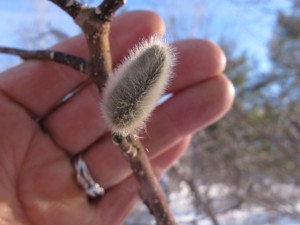
Magnolia Flower Bud
One of my favorites is my Merrill magnolia. I planted it some 15 or 20 years ago as a specimen tree in the middle of a mowed lawn. Now it is near maturity: 25 or 30 feet tall with a “wing span” of 20 feet. It has multiple stems, as many magnolia do, and smooth gray bark. The branches are loaded with large, fuzzy flower buds. These buds are bigger and better than pussy willow blossoms, and they bring joy not only for their looks now, but also for the image of what the blossoms will look like: 3-inch double white flowers that are lightly fragrant. The tree almost always blooms for me on April 23, my birthday.

Twisted Hazelnut
I love the curlicue form of purple-leafed, twisted hazelnut (also called Harry Lauder’s walking stick). It is a very interesting silhouette against the snow, and come spring it will produce lovely, glossy purplish leaves. Later in the summer the leaves will lose some of their purple hue and appear more green.
My apple trees can be a joy to look at, too. Proper pruning of apple trees can turn them into works of art. The key is to get rid of the clutter that apple trees seem determined to grow. Annual pruning to get rid of those vertical twigs called “water sprouts” makes a big difference. I tell people that a bird should be able to fly through an apple tree and not get hurt. I once found the skeleton of a bird in an unpruned apple tree, but don’t know for sure how it met its demise. I’ll start pruning in March, once the snow has melted enough to move around the trees easily.
A native tree that has a great profile is the pagoda dogwood (Cornus alternifolia). It grows branches well separated, so they remind me of person doing Tai chi, holding arms in frozen poses. I have one that grew out of the face of a retaining wall as a ‘volunteer’. Although I snipped it off when young, the roots sent a new shoot, and I let it grow. Now it is a favorite of mine in winter.
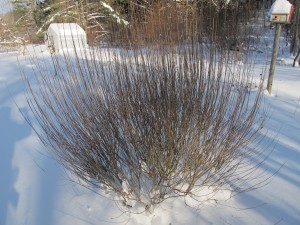
Arctic Blue Willow
My arctic blue willow looks great now, too. It is a ‘nana’ or small variety, and has hundreds of thin twigs growing vertically and very close together. Earlier in the winter it was severely bent over by an ice storm, but I shook the branches free of ice and snow, and now it is back in fine form. The 16 inches of fine snow we got recently sifted through the branches this time, giving it a great silhouette.
So go outside and really look at the “bones” of your garden on a snowy day. And if you don’t find much to look at, make plans to buy and plant some nice trees and shrubs, come spring.
Correction: A kindly soils professor e-mailed me about a recent article in which I said wood ashes could be used to substitute for limestone. He noted that trees can pick up lead and cadmium, particularly near roads, so wood ashes are not good to use in the garden. He also said they act so quickly that your soil may become too alkaline and inhospitable to soil microorganisms.
Henry Homeyer teaches pruning and general gardening. His web site is www.Gardening-Guy.com. He is the author of 4 gardening books.
Selecting and Training Flowering Trees
Posted on Thursday, May 23, 2013 · Leave a Comment
This has been a great year for flowering trees and shrubs. My Merrill magnolia had many hundreds of white blossoms in late April.
The crabapples everywhere put on a spectacular display this year. My fothergilla (a shrub with great fall leaf color) is in bloom now with its tidy white bottle-brush flowers. My ‘Olga Mezitt’ rhododendron (one of the parents of the popular PJM rhodie) is looking great and my wild azaleas are getting ready to bloom. And now the lilacs are blooming for me and I am overwhelmed with the large purple, blue, white and pink panicles (clusters of flowers). Spring has definitely sprung.
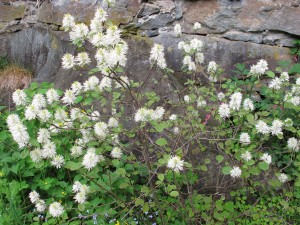
Fothergilla
All these blooms this year will certainly encourage many gardeners to buy trees and shrubs and plant them. That’s a fine idea, but if you plant now, please remember that you must keep watering them all summer if we don’t get an inch or more of rain per week. When August comes around it will be easy to have your new tree dehydrate if you get lazy or forgetful.
New trees and shrubs need a year or more to grow roots sufficient for their needs if we get hot, dry weather. So if you are forgetful or will be doing lots of traveling, you might want to hold off on planting a new tree until fall, which is also a good time for planting. Fall is cooler and more likely to be rainy.
I like to buy flowering trees and shrubs when they’re in bloom. That allows me to see the color and check out the fragrance. But there is more than just the flowers to consider when selecting a good crabapple or magnolia. Let’s start with size and price. Bigger
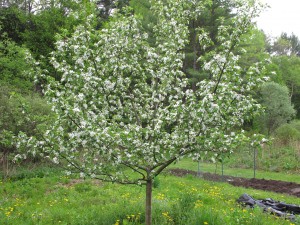
Nicely pruned apple tree
is not necessarily better. If you are on life support and don’t expect to be around in 5 years, sure, buy the biggest tree you can afford. But be aware that a bigger tree is not only more expensive – it is also harder to plant and takes more water and care. A bigger tree may have a smaller proportion of its root system intact after being dug up and put in a pot than a small tree. I like to buy smaller specimens and then train them to be a nice shape. That’s harder to do on a larger tree.
I recently visited a nice new nursery run by Henderson’s Tree Service on Rte 14 in Hartford, Vermont. There I chatted with my friend Sylvia Provost who is co-owner of the business. I asked Sylvia what she would look for if purchasing a crabapple for herself. Without a moment’s hesitation she responded. “Structure,” she said.
What Sylvia was talking about is the shape of the tree and the placement of the branches. Fruit trees produce best on branches that leave the trunk at a right angle or are aiming just slightly upward. Branches that shoot straight up are not usually good fruit and blossom producers.
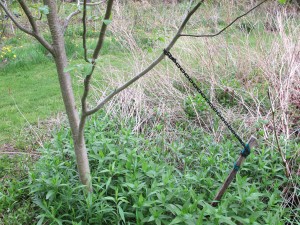
Changing the angle of a branch
And although Sylvia noted that you can train a tree to be the shape you want, it is easier to start with something that is closer to your ideal before you start training. So, for example, Sylvia said that if you have a swimming pool some distance from your patio, you should choose a tree that has an open format, one that you can see through – and see what is happening at the pool. Conversely, if you have nosy neighbors and want to screen their view of your patio, you might select a tree that has a full, dense arrangement of branches.
Generally, pruning a tree should begin in the second year of its life at your home. I often see apple and crabapple trees that have very low branches. I like to prune off those low branches to make it easy to mow around, and to have a nicer look. And if two branches are both striving to be the “leader” or the dominant, tallest stem, I remove one. And although most books say you should prune fruit trees in March or April, you can safely make a few judicious cuts now to train your tree.
You may train branches to grow at different angles by weighing them down – if you do so soon. This is an activity for spring, starting before the new layer of cambium growth has occurred. You can drive a stake into the ground and tie a branch to it for the next 2 months. A branch the diameter of a finger can weighed down by hanging a plastic pop bottle on it, then filling it with water until it bends to the correct angle.
Chris Wilson of the EC Brown Nursery in Thetford, Vermont suggested that when buying a tree, look at leaf color – leaves should be green, not tinged with yellow. He also suggested making sure the tree has branches on all sides, and that the bark has not been damaged.
So if you’ve delighted in the flowers on trees in your neighborhood this year, go get one or more. Study several specimens to find the best one. And just remember to water all summer long!
Henry Homeyer is a gardener and garden designer living in Cornish flat, NH. His Web site is www.Gardening-Guy.com.
Filed under Article · Tagged with EC Brown Nursery, flower crabapple tree, fothergilla, gardening guy, growing fruit trees, Henderson's Fine Gardening, Henry Homeyer, how to prune a tree, how to purchase fruit trees, hydrangeas, merrill magnolia, Olga Mezitt rhododendron, pruning trees, training tree branches
Spring Tasks in the Garden
Posted on Wednesday, April 25, 2012 · Leave a Comment
April has been a busy month for most gardeners because it has been warm and sunny. Our flower gardens and trees have woken up early, allowing us to do tasks we might, in other years, put off until May. Here are some jobs I‘ve been working on – and you should be, too.
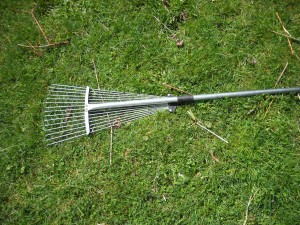
Adjustable Rake
Raking the lawn. Always one of my least favorite jobs, it needs to be done if you want a good looking lawn. But really, there are only 2 places where it’s critical: First, remove the piles of sand and gravel dumped along the edge of the driveway by the snowplow. Your lawn will suffer if they aren’t removed. Second, harvest the soil pushed up by moles in the lawn. I collect the soil from those piles and use it as fill dirt. The rest of the lawn? Any dead leaves will be chopped up by the lawnmower and disappear – and add some nice organic matter to your lawn’s soil.

Daffodils
Raking the flowerbeds. This I enjoy. I love seeing what plants have come safely through the winter, what is waking up and sending forth shoots. I rake carefully, so as not to break off the growing tips of peonies or other delicate flowers. I start with a rake to clean up around a clump of shoots, and then bend over to gently “rake” the clump itself with my fingers. I use an expanding lawn rake with a telescopic handle. I can adjust the width of the rake from about 7 inches to about 22 inches, allowing me to rake carefully in-between plants. I found the rake locally at my feed-n-grain store.
Pruning. I’m mostly done with this spring task, but I’m still tweaking apple and pear trees as I walk around the property with a holstered pruner on my hip. Recently I cleaned up lots of root suckers –shoots – coming up around the base of a crab apple tree. And I shaped up my roses, cutting back long, lanky stems to create nicely rounded plants.
I just finished pruning my grapes. They need to be cut back severely each year, as they would get too unruly if I didn’t. They produce grapes on new growth, which is stimulated by pruning. I have a 2-wire system on the south side of my barn and prune back to thicker, older canes and the 6-inch spurs that I allow to grow off them.
Planting. At this time of year my garden soil is usually cold and wet. Not so this year. I have planted seeds for carrots, beets, parsnips, scorzonera, salsify (all are root crops), parsley, spinach and greens. Peas could be planted now, though I have decided to skip them this year. I also have transplanted little lettuce plants and other interesting greens that I started indoors at the end of March, including chicory and mesclun. Some folks I know have already planted potatoes, but I wait until June.
I believe (but cannot prove) that planting potatoes in June helps to reduce problems with potato beetles. I like to say they’ve already gone to my neighbors’ potatoes, so avoid mine. But who knows? I watch for the beetles and pick any I find early on, so (hopefully) few produce a second generation.
That same technique works on slugs: control them early to prevent big outbreaks later on. I use an organic slug control product, Sluggo, which is iron phosphate covered with slug bait. Iron phosphate is a naturally occurring mineral that is said to be safe for pets and wildlife – and approved for organic gardeners.
Last fall I neglected to work on my blackberry patch, so I’ve been cleaning it up now, along with help from my intern, Gordon Moore. He cut out all last year’s fruiting canes (which die after bearing fruit). The patch has gotten to be 10 to 12 feet across, so we created a path down the middle of it by pulling out plants as needed. Then we pinned down a 2-foot wide strip of heavy landscape fabric (using landscape staples) and he covered it with a 2-inch layer of chipped branches I got from an arborist.
I weeded the patch and top dressed it with organic fertilizer and other minerals including green sand and Azomite. Green sand provides extra potassium and micronutrients from the sea. Azomite is a brand- named product that contains a wide array of finely ground rocks to provide micronutrients. After adding those minerals, we spread chipped branches around the plants, too.
To keep the blackberries from flopping over when laden with fruit, I have a 2-wire fence on the outside. The lower strand is 30 inches off the ground, the upper is 60 inches. Gordon and I tightened up the fence, which had gotten floppy. Along the center walkway I tied canes to 5-foot grade stakes as needed. It’s a huge improvement! (There’ll be no more need for blood transfusions after picking berries.)
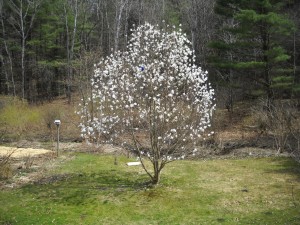
Merrill Magnolia
Finally, I spend time right now admiring my flowers. My Merrill magnolia tree has been spectacular and fragrant. Shad bushes, a native plant (Amelanchier spp.), are in full bloom now- both the planted ones and those at the edge of the road and field. All my daffodils – early, mid-season and late – bloomed at the same time this year, so I am picking them and bringing inside to enjoy. I hope you will find time, too, to slow down and enjoy your flowers.
Henry Homeyer is a life-long organic gardener and the author of 4 gardening books. His Web site is www.Gardening-Guy.com
 It struck me that winter can be pretty bleak for people who don’t have nice looking winter shrubs and trees. Judicious pruning can turn transform a messy tree full of small branches going every which way into sculpture. I recently helped a client prune a 50-year old Japanese maple into sculpture that will keep it looking great for several years – with only a few minor pruning cuts each year.
It struck me that winter can be pretty bleak for people who don’t have nice looking winter shrubs and trees. Judicious pruning can turn transform a messy tree full of small branches going every which way into sculpture. I recently helped a client prune a 50-year old Japanese maple into sculpture that will keep it looking great for several years – with only a few minor pruning cuts each year.





















